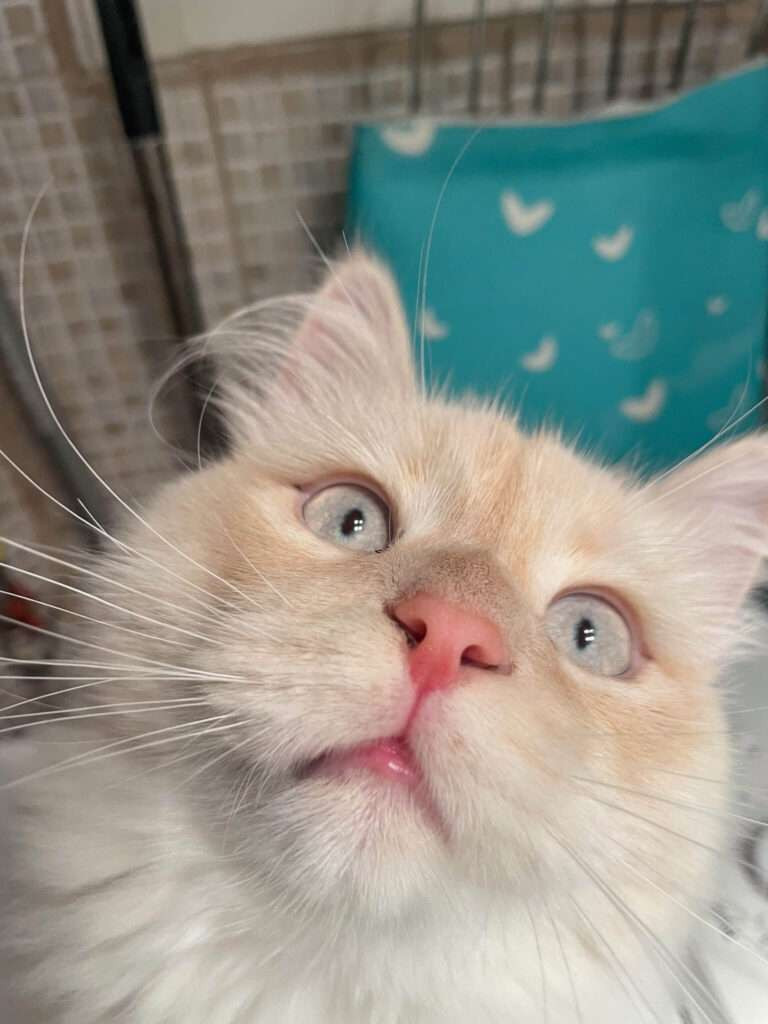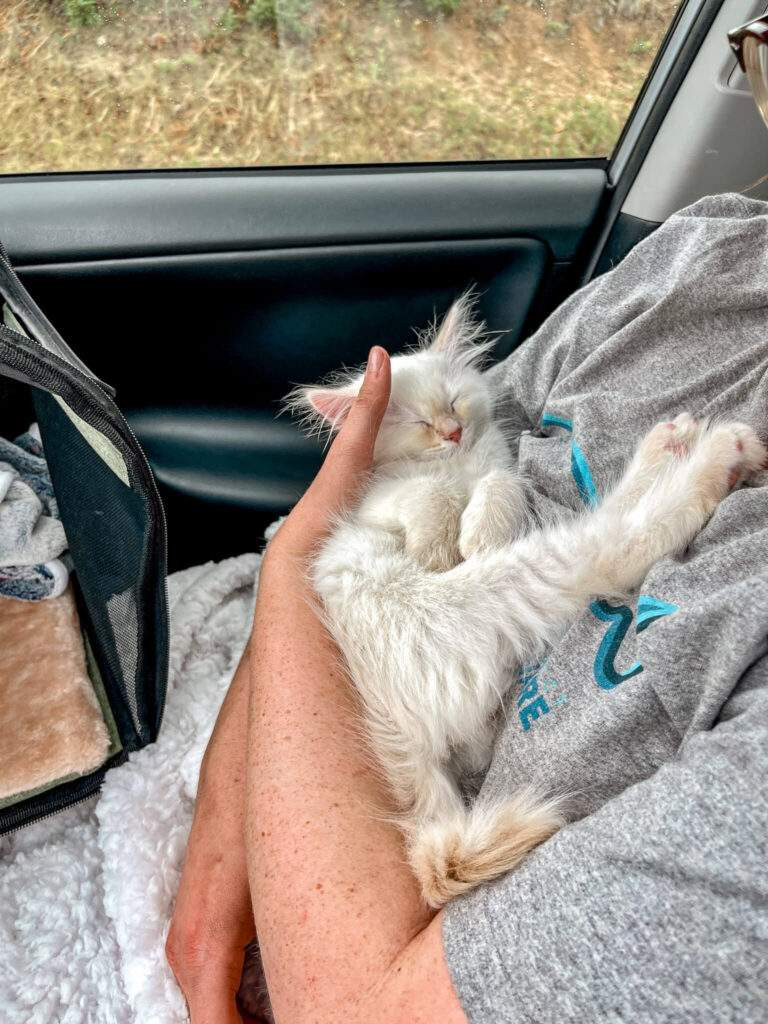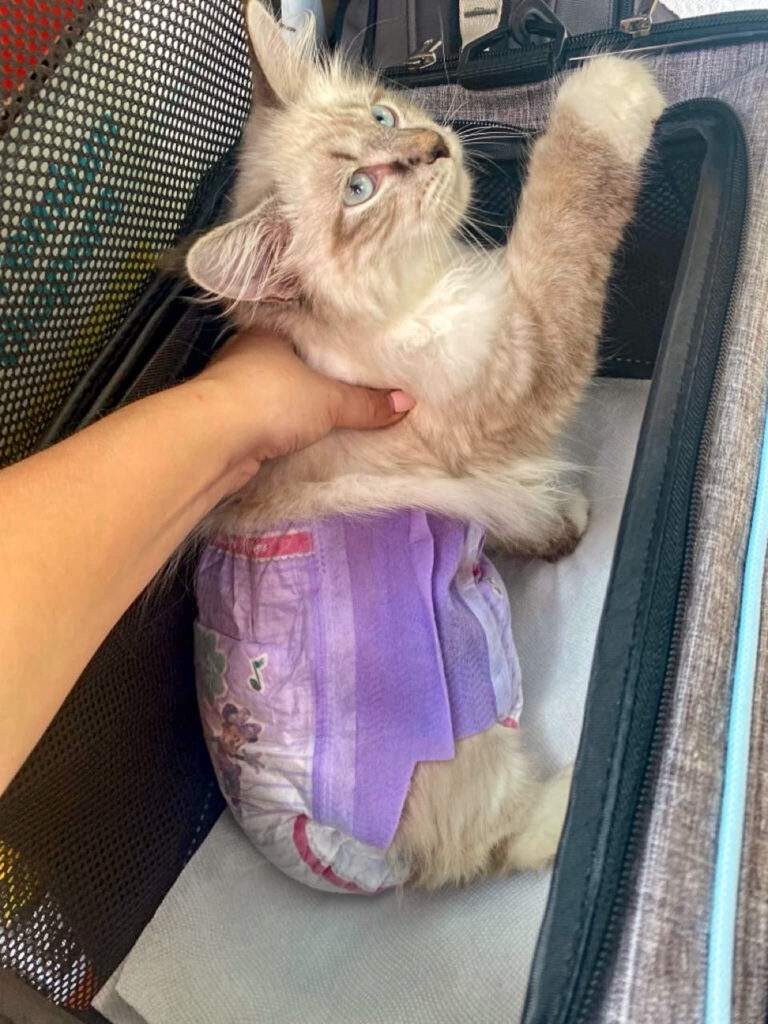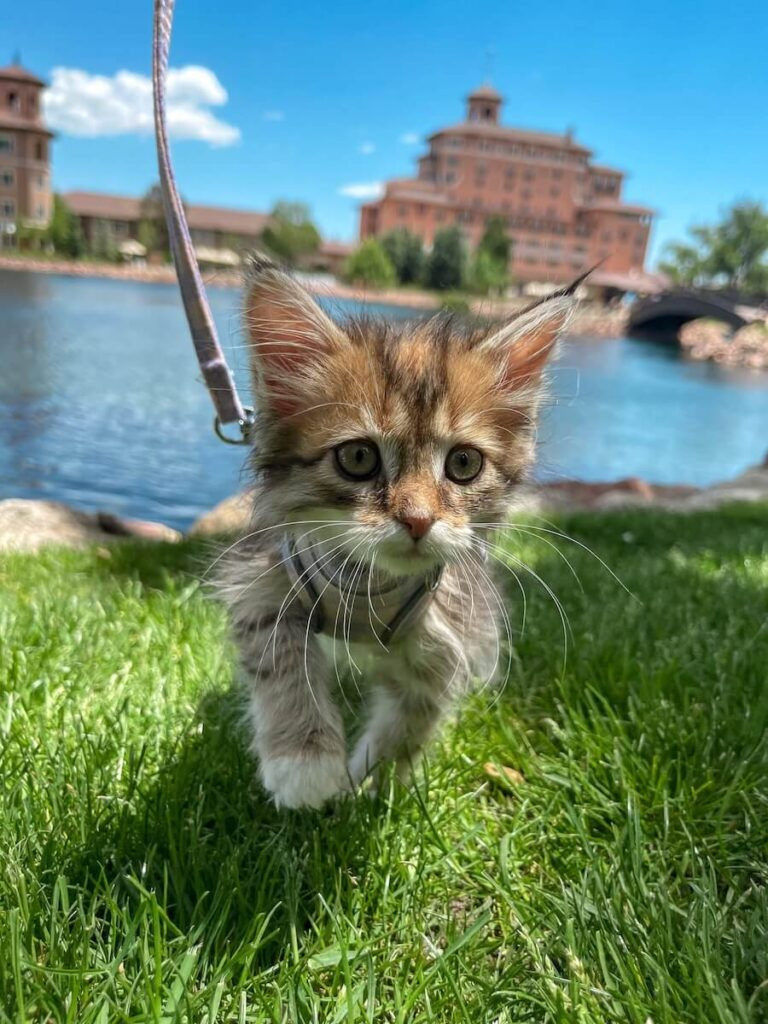Flying internationally with your cat might seem daunting, and when I first told people I was planning to fly internationally with my cat, Moshie, I was met with reactions ranging from disbelief to outright warnings about my sanity. Looking back, it was indeed a bit of an adventure, but definitely a worthwhile one.
Why Take Your Cat on an International Flight?
For me, the decision to bring Moshie on my move from Denver, Colorado to Budapest, Hungary for medical school was non-negotiable. As someone with a nomadic spirit, I hoped that having Moshie would provide a sense of stability and companionship in a new country. While my grand plan for instant grounding didn’t quite pan out (you can read more about my journey here), having my furry best friend with me made the entire overseas move infinitely better.
The biggest hurdle was figuring out the logistics. Information specific to cats was surprisingly sparse. That’s why I’ve created this comprehensive guide, drawing from my own experiences and lessons learned, to help you navigate the process of flying internationally with your cat smoothly. Consider this your step-by-step manual to make your cat’s international travel as stress-free as possible, and learn from my mistakes, so your experience isn’t the “dumpster fire” mine sometimes felt like.
This is a detailed guide, so bookmark this page for easy access as you plan your trip.
Meet Moshie: The Globetrotting Siberian
Before we dive in, let me introduce you to the star of this guide, Moshie! He’s a flame point Siberian Forest Cat, and he embarked on his first international flight at just five months old. Many people are captivated by his charm, and for good reason – he’s utterly adorable and knows it!
[
Follow Moshie’s Adventures on Instagram
Want to see more of Moshie and his sister Amelia’s travels? Follow their dedicated Instagram account “Toe Beans on the road” for daily doses of feline wanderlust!
Follow “Toe Beans on the road”](https://www.instagram.com/toebeansontheroad/)
Now, let’s get into the nitty-gritty of flying internationally with your cat, starting with essential regulations and documents.
International Cat Travel: Regulations and Required Documents
Navigating Pet Regulations for International Flights
Flying internationally with a cat involves a significant amount of paperwork and adherence to strict regulations. When I was preparing for my flight from Denver to Budapest, I relied heavily on resources like APHIS (Animal and Plant Health Inspection Service) and the US Department of State for information. While these resources were helpful, the sheer volume of information felt overwhelming.
Key takeaway: Involve your veterinarian from the very beginning and tackle the process step-by-step.
It’s important to note that while many regulations are similar for cats and dogs, there can be differences. Always confirm specific requirements for cats.
 Moshie enjoying the outdoors, highlighting the joy of pet travel
Moshie enjoying the outdoors, highlighting the joy of pet travel
Planning an International Move? Don’t miss: What To Expect From Moving Abroad
EU Pet Travel: A General Overview (From the US)
Important Disclaimer: The following information is based on my experience traveling from the US to the EU and is for informational purposes only. Regulations are subject to change, and you should always consult official sources and your veterinarian for the most up-to-date and specific instructions for your travel itinerary.
To provide a clearer picture, here’s a breakdown of the general requirements for bringing Moshie from the US to Hungary (EU):
1. ISO-Compliant Microchip
Ensure your cat has an ISO-compliant microchip. This is a standard requirement for international pet travel. If your cat’s microchip isn’t ISO compliant, you might need to bring your own scanner, which is less than ideal.
2. Minimum Age Requirement
Your cat must be at least 16 weeks old to fly internationally. This age limit may vary by destination, so always double-check the specific regulations for your destination country.
3. Rabies Vaccination
Rabies vaccination is crucial. It must be administered after microchipping, and the microchip must be scanned before vaccination. The vaccination should be valid (not older than one year in many cases). If your cat is older and has received booster shots, they may be valid for 1-3 years.
Carry the rabies certificate, which should include your cat’s microchip number. Crucially, there’s a 21-day waiting period after the rabies vaccination before you can travel to the EU.
4. EU Health Certificate from APHIS
This is where things can get complex. You’ll need a non-commercial EU health certificate if you’re traveling with fewer than five pets and not for commercial purposes.
Your veterinarian will need to perform various health tests and complete the health certificate. The signed document then needs to be submitted to APHIS for endorsement. The USDA endorsement must be obtained within 10 days of your arrival in the EU.
Once you receive the endorsed health certificate, sign the declaration section before traveling.
While this process appears straightforward, it’s often more complicated in practice. Allow ample time and prepare for potential delays and unexpected hurdles.
 Moshie enjoying the outdoors, highlighting the joy of pet travel
Moshie enjoying the outdoors, highlighting the joy of pet travel
Veterinary Visits: Start Early and Be Prepared
As the regulations highlight, multiple vet visits are essential for international cat travel. Schedule your first vet appointment as early as possible. Ideally, begin the process 3-4 months before your planned travel date. Murphy’s Law tends to apply to international pet travel preparations!
What to Expect at the Vet
My experience involved a few unexpected delays:
- Communication Lags: Initially, getting on the same page with the vet regarding all the specific requirements took time.
- Testing and Paperwork: Running necessary tests and completing the extensive paperwork took longer than anticipated.
- Vaccination Waiting Period: The mandatory 21-day waiting period after rabies vaccination is non-negotiable.
- USDA Endorsement Delays: Getting the USDA endorsement was nerve-wracking. Despite expedited shipping, the endorsed health certificate arrived just two days before my move, causing significant stress.
Lesson Learned: Start vet preparations as early as 3-4 months in advance to buffer against potential delays.
Vet Expenses and Hidden Costs
Flying internationally with a cat is not cheap. Be prepared for:
- Veterinary Service Fees: Costs for all required tests, vaccinations, health certificates, and the vet’s time spent on documentation.
- Expedited Shipping: Fees for priority shipping to receive the endorsed health certificate within the 10-day timeframe.
- Airline Pet Fees: These can range from $250 or more per flight segment.
Sedation for Cats During Flights: Proceed with Caution
Your veterinarian might suggest or prescribe calming medication for your cat, such as Gabapentin. While it might seem helpful, always test the medication on your cat before the flight.
In Moshie’s case, calming medication sometimes seemed to agitate him further. There are also potential risks associated with sedating animals during air travel.
Crucial Step: Have a detailed discussion with your vet about sedation, weigh the pros and cons, and make a decision that prioritizes your cat’s well-being.
Booking Your International Flight with a Cat
Airline Pet Policies and Costs
When booking flights, prioritize airlines known for being pet-friendly and for their international pet travel policies. I chose United and Lufthansa due to their relatively reasonable pet travel fees and international routes.
Budget at least $250 (or more) per flight segment for pet travel fees. The cost varies by airline and destination. Round-trip tickets might be slightly cheaper overall, but one-way tickets are often necessary for international moves.
While I’ve heard positive feedback about American Airlines for pet travel, their routes didn’t align with my destination to Budapest.
Cat “Passports” and Essential Documentation
Do cats need passports? Technically, yes, in the sense that they require a collection of documents for international travel. In the US, a “pet passport” generally refers to all the necessary paperwork: health certificates, vaccination records, etc. While you won’t receive a physical “passport book” from US authorities, some companies offer “pet passport packages” that compile these documents.
In the EU, a physical “pet passport” does exist and is essential for travel within the EU, including layovers. I encountered issues during check-in for a flight within Europe due to not having an EU pet passport, highlighting its importance for intra-EU travel.
For re-entry into the US, customs procedures for cats were surprisingly relaxed, but it’s always best to be fully prepared with all necessary documentation.
Choosing the Right Seat for Flying with a Cat
Seat selection can impact your comfort and your cat’s well-being during the flight. Opinions vary:
- Window Seat: Some prefer window seats to prevent people from stepping over the pet carrier in the aisle.
- Aisle Seat: I personally prefer aisle seats for easier access to get up, move around with the carrier, and access belongings. Window seats can feel cramped when managing a pet carrier and your own items.
- Avoid Middle Seats: Middle seats are generally less comfortable when traveling with a pet.
Confirm, Confirm, and Re-Confirm with Airlines
Book your flight and pet reservation well in advance, ideally more than 48 hours before departure. Airlines often have limits on the number of pets allowed per flight.
Crucially, contact all airlines involved in your itinerary, even if you booked through a single airline. My ticket was purchased through United, but the European leg was operated by Lufthansa. This resulted in confusion and issues during check-in, as pet reservations and payments weren’t always seamlessly transferred between airlines.
Verify pet reservations, fees, and specific airline requirements with each operating airline to avoid check-in nightmares.
 Moshie and Amelia in a carrier, ready for travel, emphasizing carrier comfort
Moshie and Amelia in a carrier, ready for travel, emphasizing carrier comfort
Avoid Cargo: Keep Your Cat in the Cabin
Never put your cat in cargo if possible. Cargo holds can be dangerous for pets due to:
- Poor Ventilation
- Extreme Temperature Fluctuations
- Rough Handling
Keeping your cat in the cabin allows you to monitor them, provide comfort, and ensures a safer travel experience.
If cargo travel is unavoidable, consider using a professional pet transport service. If you must use cargo, follow these tips from the Humane Society:
- Book direct flights and travel on the same flight.
- Inform the captain and flight attendants about your pet in cargo.
- Avoid flying brachycephalic (short-nosed) breeds in cargo.
- Choose flight times to avoid extreme temperatures.
- Use a secure collar that won’t snag.
- Clearly label the carrier with your contact information.
- Trim your cat’s nails.
- Use sedatives cautiously.
- Avoid peak travel periods.
- Carry a recent photo of your cat.
- Inspect your cat and carrier upon arrival and seek immediate vet care if needed.
Document Organization: Your Kitty’s Paper Trail
Create a Master Document Checklist
Organization is key when flying internationally with a cat. Adopt a “more is more” approach and bring printed copies of all essential documents.
Create a “master checklist” of all required documents and organize them logically for easy access at check-in and customs. At a minimum, ensure you have:
- Rabies Certificate
- Microchip Certificate
- Veterinary Health Check Certificate
- USDA Endorsed Health Certificate
- Airline-Specific Pet Travel Forms (e.g., Lufthansa form)
- Country-Specific Entry/Exit Requirements for both origin and destination countries.
Remember, documentation requirements vary significantly based on your origin and destination. This checklist is tailored for US to EU travel.
 Moshie and Amelia in a carrier, ready for travel, emphasizing carrier comfort
Moshie and Amelia in a carrier, ready for travel, emphasizing carrier comfort
Choosing the Right Cat Carrier and Carrier Training
Essential Features of a Cat Carrier for International Flights
Finding the right carrier is crucial for your cat’s comfort and airline compliance. Look for these features:
- Airline-Approved Dimensions: Verify size restrictions with both airlines involved in your itinerary. Carry dimensions are often strict, and non-compliant carriers can lead to denied boarding.
- Expandable Design: Carriers with expandable sides offer extra space during layovers, allowing your cat to stretch and move more comfortably within the confined space.
- Backpack Style: A backpack carrier with hip and chest straps distributes weight effectively, especially helpful for heavier cats like Siberian Forests. Backpack straps can also be wrapped around luggage handles for easier airport navigation.
- Comfortable Interior Space: The carrier should allow your cat to stand, turn around, and lie down comfortably, especially for long-haul flights.
Two carriers I considered:
- Non-Expanding, Spacious Carrier (like Travel Cat): Offers generous space and flexibility, though not expandable. Travel Cat Carrier
- Expandable Backpack Carrier: Slightly smaller but expandable for layovers, and backpack style for easy carrying. This is the one I chose for Moshie.
[
You Might Also Like
For more pet travel gear recommendations, check out my comprehensive pet checklist for full-time RV living with cats and a dog.
Learn More](https://thebucketlistmermaid.com/pet-adventure-gear/)
Moshie and Amelia content in their cat carrier, ready for a camping adventure, demonstrating the versatility of a well-chosen carrier.
Carrier Training: Making the Carrier a Safe Haven
Carrier training is vital to reduce your cat’s stress during travel. Start well in advance:
- Positive Association: Place your cat’s favorite toys, a comfort blanket, and treats inside the carrier.
- Feeding in the Carrier: Offer meals and treats inside the carrier to create positive associations.
- Gradual Acclimation: Encourage your cat to enter the carrier voluntarily for short periods, gradually increasing the duration.
- Practice Trips: Take your cat on short car rides in the carrier to desensitize them to travel motion. We even took Moshie camping in his carrier!
Goal: Make the carrier a safe, comfortable space where your cat feels secure and relaxed. While my training was good for shorter durations, longer flights require even more extensive preparation.
Socialization for Airport Encounters
Beyond carrier training, socialize your cat to people. Airports are busy environments, and a socialized cat will handle the attention better.
- Exposure to Strangers: If your cat is naturally social (like Moshie), airport attention might be welcome. Moshie even enjoyed being held by strangers in terminals!
- For Less Social Cats: If your cat is shy or anxious around strangers, consider a carrier with covered sides to minimize visibility and unwanted interactions. Politely but firmly set boundaries with overly enthusiastic fellow travelers.
International Flight Checklist: What to Pack for Your Cat
Congratulations, you’ve made it to flight day! Pack these essentials to ensure a smoother journey:
Essential Cat Travel Kit
- Portable Litter Box: Collapsible travel litter boxes are ideal. I used a flexible travel bag in a pinch, but a proper portable litter box is much cleaner and easier.
- Small Bag of Litter: Double-bag a small amount of litter for bathroom breaks. Even a tiny amount of litter can be sufficient for cats to relieve themselves in an unfamiliar environment.
- Treats: Essential for positive reinforcement, rewarding good behavior, and distracting your cat if they become vocal.
- Food: Offer small amounts of food to distract your cat or settle their stomach, but avoid overfeeding before or during the flight to prevent accidents.
- Calming Spray (Pheromone Spray): While effectiveness varies, calming pheromone sprays might help reduce anxiety. Consult your vet.
- Favorite Toys: Familiar toys provide comfort and a sense of security.
- Calming Blanket/Anxiety Blanket: A familiar, comforting blanket can significantly reduce anxiety. Moshie loves his anxiety blanket and often sleeps on it in his carrier.
- Harness and Leash: Crucial for security during TSA checks and bathroom breaks outside the carrier. Ensure the harness fits securely and consider adding ID tags or a pet tracker.
- All Required Documents: Keep all your organized documents readily accessible throughout your journey.
 Nikita in a diaper on a flight, highlighting alternative solutions for pet travel
Nikita in a diaper on a flight, highlighting alternative solutions for pet travel
Airport Arrival: Arrive Early and Be Patient
Navigating Airport Check-in with a Cat
Mentally prepare for a potentially lengthy and stressful check-in process. Arrive at the airport at least 3 hours before your international flight, possibly even earlier if you anticipate complications.
Outbound Flight (US to EU): My check-in in Denver was relatively smooth, adding about 15 minutes to the process.
Return Flight (EU to US): The return journey was a check-in nightmare! I encountered numerous issues:
- EU Pet Passport Demand: Airline staff insisted on an EU pet passport, which I didn’t have (and technically wasn’t required for transit).
- Reservation Issues: My pet reservation couldn’t be found in the system.
- Payment Discrepancies: Confusion about pet fees already paid.
- Conflicting Regulations: Misinformation about pet entry restrictions into Germany and Denver.
Despite the chaos, and after significant delays and persistence, I was eventually allowed to proceed.
Lessons Learned:
- Arrive extremely early.
- Mentally prepare for potential check-in delays and challenges.
- Thoroughly research pet regulations for all countries involved, including layovers.
- Double-check and re-confirm pet reservations with all airlines.
- Keep all documents and payment confirmations organized and readily accessible.
TSA Security Checks with a Cat
Inform TSA officers immediately that you are traveling with a cat. You will need to remove your cat from the carrier for screening.
- Harness and Leash Essential: Use a secure harness and leash to prevent escapes during the TSA process.
- Practice Makes Perfect: Practicing removing and replacing your cat in the carrier beforehand can make the TSA process smoother.
- Expect Attention: Be prepared for extra attention from TSA staff and fellow travelers. During my chaotic return flight TSA in Germany, officers even spent 30 minutes playing with Moshie before waving us through!
 Traveler in Hungary after moving with a cat, celebrating successful relocation
Traveler in Hungary after moving with a cat, celebrating successful relocation
Waiting for Your Flight: Airport Layovers with a Cat
Long layovers can be challenging for cats confined to carriers.
- Expanded Carrier Space: Utilize the expandable feature of your carrier to give your cat more room during layovers.
- Seek Quiet Areas: Find a quiet, less crowded corner of the airport to provide a calmer environment.
- Bathroom Breaks: Take your cat for bathroom breaks in designated pet relief areas or family restrooms (with permission).
- Controlled Exploration (If Permitted): If airport rules and space allow, and your cat is leash-trained and social, consider briefly letting them out of the carrier in a secure area to stretch their legs (with harness and leash on). Always ask airport staff for guidance and permission. During a 6-hour layover, Moshie enjoyed some supervised time outside his carrier, which attracted friendly attention from other travelers.
Important Note: Not all cats are social or comfortable outside their carriers in public spaces. Prioritize your cat’s comfort and safety. If your cat is anxious or fearful, it’s best to keep them securely in their carrier.
Moshie “assisting” with medical school studies, showcasing the comforting presence of pets during challenging life transitions.
Boarding and In-Flight Comfort for Your Cat
Pre-Boarding Preparations
- Gate Agent Check-in: Upon arrival at your gate, approach the gate agent to inform them you are traveling with a cat and re-confirm your pet reservation.
- Charm Factor: Your pet might just charm gate agents into offering better seating options! On my return flight, gate agents were incredibly helpful and even rearranged seating so I could have an entire row to myself and Moshie could have extra space.
- Document Readiness: Have all your documents readily available for boarding.
Onboard Etiquette and Cat Care
- Introduce Your Cat to Seatmates: As soon as you are seated, introduce yourself and your cat to your seatmates.
- Allergy Awareness: Politely ask your seatmates if they have any cat allergies. (Moshie is hypoallergenic, but it’s still courteous to ask).
- Treat it Like Traveling with a Toddler: Traveling with a cat can be similar to traveling with a toddler – expect moments of cuteness, occasional vocalizations, and the need for patience and flexibility.
- Address Vocalizations: If your cat meows or cries, try gentle reassurance, offering a treat, or briefly petting them through the carrier. If your cat is generally well-behaved, like Moshie, fellow passengers are often understanding and sympathetic. Open communication and politeness go a long way.
- Bathroom Breaks: Inform a flight attendant if you need to use the restroom to set up a makeshift litter box. Clean up thoroughly after use.
One passenger on my flight, who was nervous about her first long-haul flight, found comfort in petting Moshie in his carrier for a couple of hours!
 Emmy enjoying travel at The Broadmoor, showcasing positive pet travel experiences
Emmy enjoying travel at The Broadmoor, showcasing positive pet travel experiences
Keeping Your Cat Calm and Quiet During the Flight
If your cat becomes vocal or restless during the flight, try these calming techniques:
- Small Food Portions: Offer 2-3 small pieces of food slowly.
- Hand in Carrier: Place your hand inside the carrier to pet and reassure your cat. Even just having your hand nearby can be comforting.
- Give Them Space: Sometimes, less is more. Avoid over-fussing. Allow your cat to settle down on their own with minimal interaction, while still keeping a comforting hand nearby or checking in quietly.
- Bathroom Breaks: Scheduled bathroom breaks can provide relief and a change of scenery.
Emotional Considerations for You (The Human Traveler)
Traveling internationally with a cat can be emotionally taxing for you as well. Feelings of guilt or worry about your cat’s well-being are normal.
- Perspective Shift: Remind yourself that this is a temporary situation. One or two days of travel stress is a small price to pay for having your beloved companion with you long-term, especially if you are moving abroad.
- Not for Frequent Short Trips: International flights are not ideal for frequent short trips with cats. Reserve them for essential moves or long-term relocations.
- Worth it for Long-Term Relocation: If you are moving abroad permanently or for an extended period, the temporary travel stress is outweighed by the joy of having your cat with you in your new home.
Customs and Arrival Procedures
Navigating Customs with Your Cat
Upon arrival, be prepared for potentially hectic customs procedures. Gather your belongings and your (likely tired) cat.
- Border Control: Proceed through border control as usual.
- Customs Inspection (Potentially Minimal): Customs procedures for pets can vary. In my case, customs was unexpectedly closed upon arrival in Budapest.
- Seek Assistance if Needed: If customs is closed or unclear, locate an airport official for guidance. I eventually found an official who briefly reviewed my documents and waved me through. Customs interactions can be brief and perfunctory, or more thorough – expect anything and be prepared.
- Respect Customs Officials: Always treat customs and border officials with courtesy and respect.
After customs, collect your luggage, secure your cat, and you’ve officially arrived in your new country with your feline companion!
A picture of baby Moshie, a sweet reward for readers who have reached the end of this comprehensive guide.
My Honest Opinion on Moving Abroad with a Cat
Moving abroad with a cat is a significant undertaking, but incredibly rewarding. I cannot imagine my experience in Hungary without Moshie.
Important Considerations:
- Stress on Cats: International moves are stressful for humans and even more so for cats. Cats are creatures of habit, and some may not adapt well to new environments or travel.
- Cat’s Personality and Health: Consider your cat’s personality, temperament, and health before deciding to move them internationally. Is your cat adaptable? Do they have any pre-existing health conditions that might be exacerbated by travel stress?
- Adjustment Period: Be prepared for an adjustment period in your new country. Moshie experienced stress-related urinary issues initially in Hungary, likely exacerbated by my own medical school stress. It took time for him to fully adjust.
Ultimately: If your cat is adaptable and healthy, moving abroad together can be a deeply enriching experience. However, prioritize your cat’s well-being and carefully consider if an international move is truly in their best interest, or primarily for your own desires.
Final Thoughts on Flying with a Cat Internationally
Flying internationally with a cat is an art that requires patience, preparation, and a healthy dose of humor. It’s not always easy, but it is absolutely achievable. If I can do it, you can too!
If you’re planning international pet travel, I hope this guide helps you navigate the process with greater confidence. Share your experiences and tag me on social media – I’d love to hear about your adventures!
Moshie Update
Moshie is thriving! After leaving medical school and embracing full-time RV travel, Moshie and his sister Amelia are living their best lives on the road. They enjoy hiking, exploring new places, and relaxing in their RV home.
Travel Resources for International Pet Relocation
Amazon Storefront – Shop hand-picked pet travel essentials and adventure gear.
Hopper – Find affordable flights for your international journey.
Booking.Com & VRBO – Accommodation options for pet-friendly stays.
GetYourGuide & Viator – Explore pet-friendly tours and activities at your destination.
TourHub – Multi-day tours for adventurous travelers. Use code ALEXANDRA1GURU for a discount.
Discover Cars & Big Bus Tours – Transportation options for exploring your destination.
Chase Freedom Unlimited – Credit card for travel rewards and cashback.
Airalo – eSim cards for affordable international mobile data.
VisitorsCoverage – Travel insurance for peace of mind.
